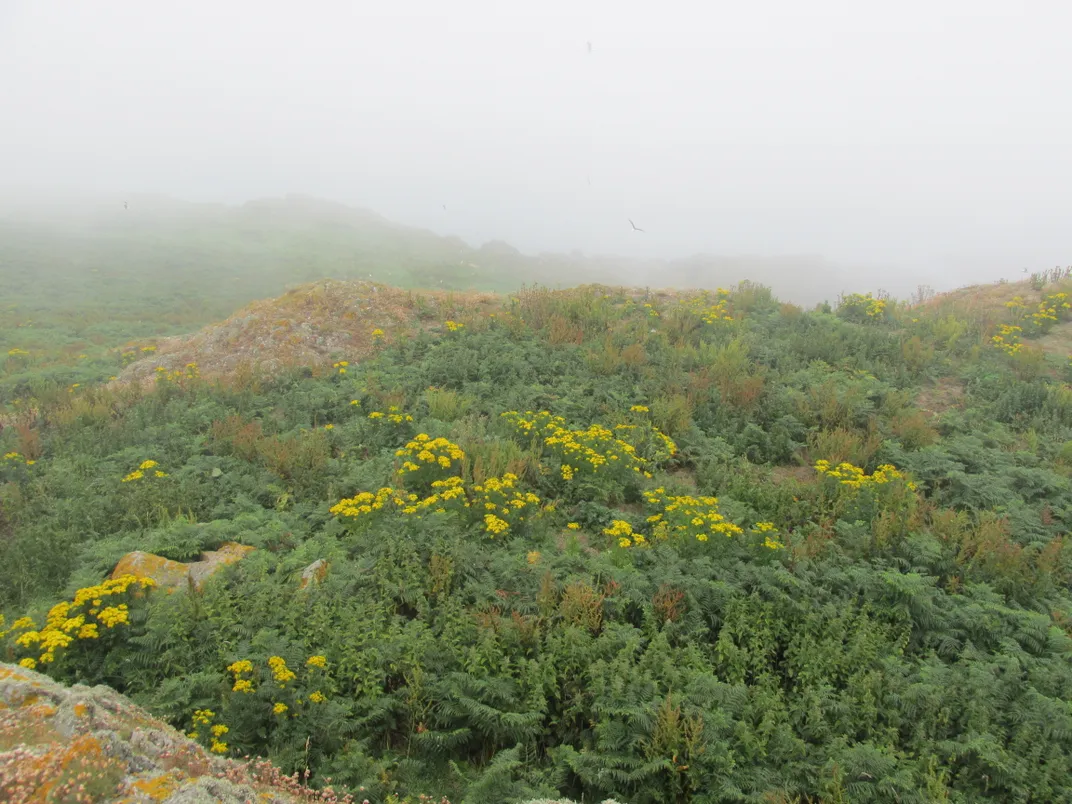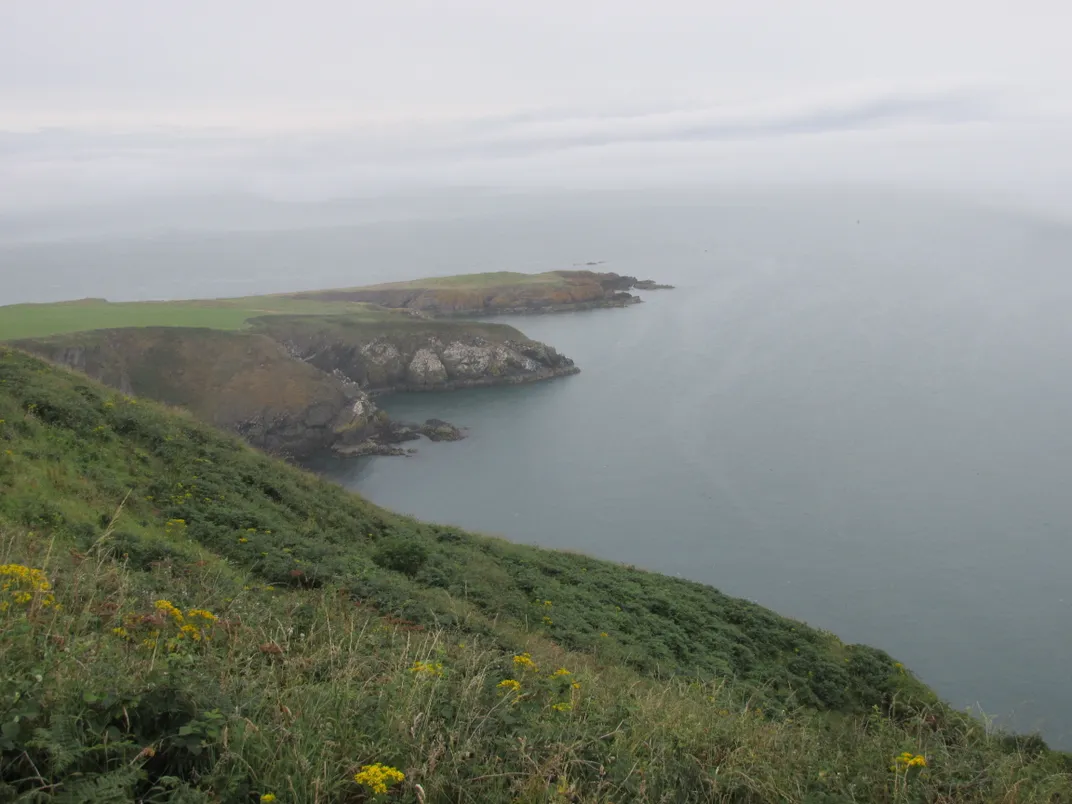What the Heck Are Wallabies Doing in Ireland?
Normally spotted in Australia, the marsupial species is thriving on a remote island off the Irish coast
/https://tf-cmsv2-smithsonianmag-media.s3.amazonaws.com/filer/bd/35/bd35c5f2-7b91-4f81-85b4-c1bac8492c9a/img_0139.jpg)
Not far off the coast of Ireland’s County Dublin, there’s a private island with some unlikely inhabitants. Along with the native bird colonies and a herd of cattle, the island, called Lambay, is home to Ireland’s only wild mob of wallabies.
“You don’t really believe it till you see them,” says local guide Eoin Grimes, who leads tourists on hikes around the island. “The first time I came out here I was like, ‘What the hell is going on here?’”
At first glance, the sighting of a wallaby emerging from a cool fog off the Irish Sea doesn’t seem real. The steep, rocky cliffs and the wet Irish weather are far from the usual depictions of the Australian brush, about 9,000 miles away. The conditions on Lambay, however, have proven to be almost perfect for the wallabies. The cliffs around the perimeter—and the rocky ground nearby—are a fair substitute for wallabies’ natural environment in Australia, where they favor rugged terrain. The 600-acre island sits three miles off the eastern coast of Ireland, offering isolation that seems to suit the shy wallabies. They are much less aggressive than their well-known counterpart, the kangaroo, and Lambay is a private island with few visitors to disrupt or threaten them.
The one condition on the island that might give someone pause is the temperature. On Lambay, the warmest days of the year are often in the 60-degree range, while the coldest days can dip into the low 40s. By contrast, Australia's island state of Tasmania, where wallabies usually abound, enjoys heat in the 80s and above in summer. Only the coolest parts of the state near the coast and in the highlands see temperatures as low as the 30s and 40s. “They don’t really do well with cold,” says wallaby expert Kevin Drees, director of animal care and conservation at the Blank Park Zoo in Des Moines, Iowa. To help them handle the Irish winter, the Lambay wallabies grow dense coats of fur.

The island first became home to a bunch of wallabies during the 1950s and 1960s when the Barings, a well-known banking family that has owned the island since 1904, decided to raise them. There are rumors that Cecil Baring, the original purchaser of the island, introduced a number of species including tortoises and lizards, but none of them survived. His son Rupert had dreams of opening a zoo on Lambay, but his plans never came to fruition.
Peter Wilson was director of the Dublin Zoo in the mid-1980s when its wallaby population expanded rapidly. Their enclosure was too small to house all of them, and Wilson had a difficult time finding the excess wallabies a new home. A wildlife park near Cork in southern Ireland took a few, but no other zoo would take the rest. Wilson said he was sure Australia would not want them back either. Not wanting to euthanize the animals if he could find them a home, Wilson turned to the Baring family, whose private island was an ideal choice with its extant population of the species. Bringing new wallabies to the island would even help the older mob survive by adding new genes to the pool.
Wilson put seven wallabies in crates and shipped them to the island on a fishing trawler. They were then transferred to tractor and trailer and taken to the highest point on the island. Once they were let loose, they immediately ran into the bushes for cover.
The species that inhabits the island is known as the red-necked wallaby. Drees says they are adaptable animals with an impressive track record for survival. In the mid-1800s, several wallaby species, including red-necked wallabies, were introduced to parts of New Zealand. They adapted a little too well—the New Zealand government now considers them to be an invasive species and is working to get rid of them. “It’s sort of like the white-tailed deer of the [marsupial family],” says Drees.
Aware of the wallabies’ ability to survive in unconventional habitats, Wilson did not doubt that the zoo’s residents would be able to make it on their own on Lambay, because the island seemed to have everything they needed. Since their arrival, the former zoo wallabies have thrived. “It’s a wonderful sanctuary for them, if you like, perfect habitat,” says Wilson. “There’s lots of thick vegetation for cover when the weather’s cold, and there’s a lot of grass and things for them to eat, so it’s an absolutely perfect place for them.”
It’s unclear how many animals were on the island before the new ones arrived, and it’s difficult to do an official count because the wallabies are not tagged. There are too many places for them to hide for anyone to count them all. But Wilson says the population has steadily grown, and he estimates between 30 and 50 wallabies live on Lambay today. Because the island is so isolated, it isn’t necessary to keep track of the wallabies at all times.
“We wanted to put them on an island because we knew we were introducing a species that could run wild and take over,” says Wilson. “If we put them on an island like Lambay, there’s no way they could escape from it.”

The wallabies have yet to become a problem for the island's other resident species. They live among thousands of sea birds, 120 cattle, 80 fallow deer and just a few humans, according to Matthew Jebb, director of the National Botanic Gardens in Dublin and a Baring cousin. For now, the island boasts only four permanent human residents.
Unlike the wallabies still in the Dublin Zoo, the animals on Lambay do not have human care and constructed enclosures to ensure their survival in an unfamiliar environment. Still, Jebb says the wild wallabies have found their own safety nets, such as munching on hay put out for cattle during hard winters.
Drees has not visited the island or studied the wallaby population that lives there, but knowing their capacity for survival, he questions the long-term effects of introducing them to Lambay. “If the habitat is a good environment, the capacity of the island will be reached,” says Drees. “If the population is too high, it will be a health problem, or food will be limited.”
Drees says that human intervention is usually inevitable with an introduced exotic species. It’s just a matter of when that will be necessary. Aside from putting hay out, the humans on Lambay currently do very little to manage the wallaby population, apart from occasional culling when the population seems to be growing too rapidly. According to Jebb, they only take these measures when the animals encroach on the gardens.
While wallabies can swim, Drees doubts they would be able to make it all the way to the Irish mainland. Still, if the population did explode and they managed the long swim to shore, the wallabies would be a definite threat to the rest of the animals in Ireland, especially cattle, which have a similar diet.
In the meantime, people can attempt to glimpse a wallaby during a visit to Lambay as part of bird-watching and nature groups or through Eoin Grimes’ small tourism business. The population remains small enough for them to go unnoticed, and they are not used to people staring at them in an enclosure the way they would be in a zoo. Instead, they often hide in the bushes. For many tourists, the Lambay wallabies remain a mystery, leaving people to wonder whether they really exist.
When I visited the island in July, fortune was on my side. After more than two hours of hiking, three wallabies appeared on a dirt path going through the bushes. The descending fog made it difficult to see them, and their appearance was fleeting, lasting only about 10 minutes before they hopped back into cover. Then they were gone.
/https://tf-cmsv2-smithsonianmag-media.s3.amazonaws.com/accounts/headshot/colleenc.png)
/https://tf-cmsv2-smithsonianmag-media.s3.amazonaws.com/accounts/headshot/colleenc.png)